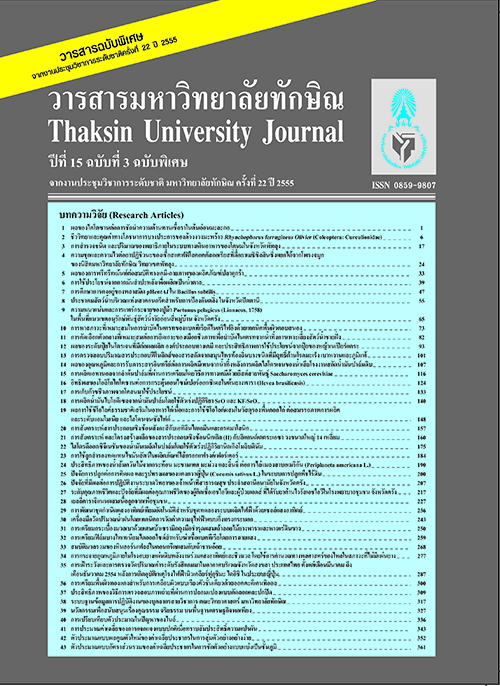ปัจจัยการปลูกต่อการติดผล และรูปทรงผลของแตงกวาญี่ปุ่น (Cucumis sativus L.) ในระบบการปลูกพืชไร้ดิน
Main Article Content
Abstract
ศึกษาปัจจัยการปลูก ด้านสูตรอาหาร สภาพแวดล้อมการปลูก ของแตงกวาญี่ปุ่นในระบบการปลูกพืชไร้ดิน ที่มีต่อการติดผลและรูปทรงผล โดยทำการปลูกต้นกล้าในระบบ substrate culture ทั้งในโรงเรือนและนอกโรงเรือน พร้อมให้สารละลายธาตุอาหาร 2 สูตรคือ สูตร Benoit และ Enshi-shoho ผลการทดลองพบว่าการปลูกแตงกวา ในระบบพืชไร้ดินด้วยสูตรสารละลายต่างกันไม่มีผลต่อจำนวนดอกเพศเมีย เปอร์เซ็นต์การติดผลและรูปทรงผล การปลูกในสภาพโรงเรือนมีเปอร์เซ็นต์การติดผลและรูปทรงผลปกติต่ำกว่าการปลูกนอกโรงเรือน แตงกวาญี่ปุ่น ที่ปลูกในโรงเรือนและนอกโรงเรือนมีเปอร์เซ็นต์การติดผล 3.2 และ 75.2% และมีเปอร์เซ็นต์ผลตรงในและ นอกโรงเรือน 0 และ 32.5% ตามลำดับ การโค้งงอของผลเกิดได้ทั้งขั้วผล กลางผลและปลายผล บริเวณเนื้อผลที่โค้ง งอไม่พบเมล็ดที่สมบูรณ์ การห่อผลที่เริ่มแสดงการโค้งงอ สามารถชักนำให้ผลโค้งงอเป็นผลตรงปกติได้
A study on effects of nutrient solutions and growing conditions on fruit set and fruit shape of Japanese cucumber in soilless culture was examined. Cucumber seedlings were grown in substrate culture with two growing conditions; in the greenhouse and outdoor. Benoit and Enshi-shoho solutions were applied. The result showed that two nutrient solutions had no effect on fruit set and fruit shape percentage. In the other hand, growing conditions had effect on percentage of fruit set and fruit shape. Japanese cucumber grown in the greenhouse and outdoor had 3.2% and 75.2% of fruit set and 0% and 32.5% of regular fruit shape, respectively. Irregular shape could occur at stem end, middle or blossom end of fruit. At irregular pulp, completely seeds were not found. Fruits from bagging at early stage of irregular shape by paper-bagging turned to be a normal shape.


